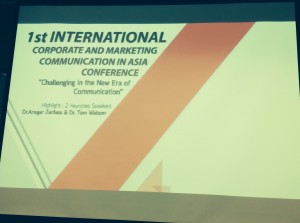 Last week has been extremely busy with travels, prescription work, visit this site meetings and presentations both in Asia and Europe.
Last week has been extremely busy with travels, prescription work, visit this site meetings and presentations both in Asia and Europe.
It started with a lengthy journey to Thailand and a much expected participation in the 1st Marketing and Communication in Asia Conference, advice organized by Bournemouth University and Chulalongkorn University. It has been an opportunity to a place I very much enjoyed visiting and teaching and it has been a return faciliated by internal funding awarded by BU to Prof Tom Watson and myself to organize this conference.
It has been marvelously well organized with our Thai hosts ensuring that we had the best of access to campus, venues and catering, making us and the conference participants most welcome and providing a friendly yet inviting atmosphere to present our research, give and receive feedback and create new contacts.
I also had an opportunity to present a paper I co-authored with Nathaniel Hobby, my colleague from the PR department of Bournemouth University, a social media expert and advocate in his own right supporting very much the university’s online outreach, monitoring and measurement.
Our paper, well received, covered the results of a recent evaluation of the monitoring tools the PR department uses to monitor social media.
“Exploratory in nature, this paper raises valuable questions about the differences in search, reach and engagement in higher education conversations relevant to international recruitment and reputation of UK based HEIs taking place amongst UK and Asia-based audiences.†We focused on Meltwater Buzz, Vocus and Hootsuite and ran listening campaigns using a combination on keywords for a month earlier this year (July 2013). Out of the platforms used, to which we had premium accounts, Meltwater Buzz provided the most results and insight indicating a wider ability to search, visualize and monitor online conversations.
However, the lack of results on Vocus and Hootsuite led to highlighting of important points:
- The importance of timing – our campaign took place in July at a time when academic years both in the UK and abroad on a break.
- The importance of access – both technical and linguistic. Many of the Asian countries not only have their own language but also their own alphabet. While it is a reasonable assumption that potential students interested in studying at BU would search and speak about it in English, this excludes part of their personal conversations which can take place on their own language. Moreover, with countries like China (and to a degree Russia as well) where there are a country-specific popular social networks and where content is sometimes behind a firewall, relying on western monitoring platforms means mining only a limited amount of the data.
- The necessity of allocated resources both financial and human to monitoring social media. This includes translation as well as trends analysis, insight and responding to online direct or indirect queries.
While assessing the ease of use of the monitoring tools, our paper also proposed a model of how HEIs could and should monitor social media effectively.
These included:
- The role that social media plays in their wider communication strategy (whether recruitment, reputation, research dissemination)
- The target audiences (this implies a thorough analysis of the access and skills of the public targeted but also of the knowledge and language skills of the team managing the communications).
- The human resources available for social media on a daily basis. In the current, multimedia climate it has become of paramount importance that proper resource is given to a social media post within an institution. This study has shown the value of analysing social media and social media is no longer simply the act of posting content online. The analysis emphasized the importance of trends research, online monitoring and content planning to reflect and address those trends. Furthermore, the need to constantly monitor social media (for mentions and direct contact the institution may have from its audience) and provide timely responses to the posts mined highlight the heavy human resource investment needed.
- The financial resources available for social media monitoring, management and measurement. (p. 19 in our manuscript – Please leave me a message here or tweet me if you’d like to read the full paper)
The powerpoint from the presentation is below:
